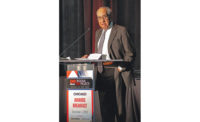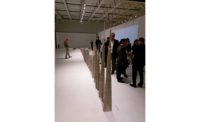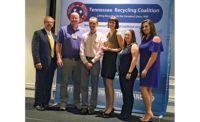Skender joined Chicago Mayor Brandon Johnson and other community leaders on July 27 to celebrate the groundbreaking of Fifth City Commons, a 43-unit affordable housing complex and retail space building on a 1.5-acre site that has been vacant for decades on Chicago’s West Side. Preservation of Affordable Housing was selected to develop the vacant space as part of the global C40 Reinventing Cities competition for designing sustainable developments on urban sites.
Skender will construct a three-story, mixed-use building offering sustainable one-, two- and three-bedroom rental units for East Garfield Park residents who make between 30% and 80% of the area median income. The project will include community rooms, a resident terrace and fitness room, three laundry rooms and onsite management offices.
“More than 100 years after Chicago showed the world how to design and build skyscrapers, today we are poised to lead the way in the development of sustainable affordable housing,” Johnson told attendees.
The complex will be all electric, with sustainable features such as triple pane windows and air sealing to lower the building’s energy needs in accordance with Passive House principles. Two-thirds of all its energy needs will be supplied by rooftop solar panels. The property will also have mature landscaping, EV charging stations, extensive bicycle parking and onsite composting.
Skender will serve as general contractor in a joint venture partnership with Ashlaur Construction; architects Perkins + Will and Nia; and engineering firms dbHMS, Rubinos & Mesia Engineers, Omni Ecosystems and TERRA Engineering.
Skanska broke ground in August on a two-story mass timber building that will be the first of its kind in Cincinnati. The building will serve as the headquarters for Cincinnati Public Radio.
The $32-million, 35,000-sq-ft building will feature two on-air studios, two interview studios, one performance studio, 11,000 sq ft of office space and a public gathering area. It is slated to open in winter of 2024.
Cross laminated timber will be used in the building’s construction, while the entire column and beam structure, second floor, roof structure as well as a selection of interior shear walls and exterior perimeter walls will be made from mass timber.
“While most mass timber projects are hybrids in which the lateral system is comprised of steel or concrete, this project’s lateral system is composed of cross-laminated timber shear walls, making it an almost completely mass timber superstructure,” says Dean Lewis, director of mass timber and prefabrication at Skanska.
Aaron Sparn, project executive for Skanska, says the project will provide some interesting challenges.
“Being a mass timber building offers some unique planning to the project compared to typical commercial construction,” he says. “Water mitigation strategies had to be developed to ensure that all water is kept off the mass timber decks to avoid water/steel connection staining of the mass timber as we dry-in the building.”
The construction team also is working on a tight site and reducing handling of the materials to maintain quality.
“Due to our limited laydown area on site, we are coordinating with the mass timber supplier to install the beams, columns and decking off the delivery trucks as they arrive on site, which will ensure less handling of material and result in better quality,” Sparn says.
Mass timber also offers numerous environmental advantages, including reduced carbon emissions, increased energy efficiency and the use of renewable resources, Sparn says.





Post a comment to this article
Report Abusive Comment